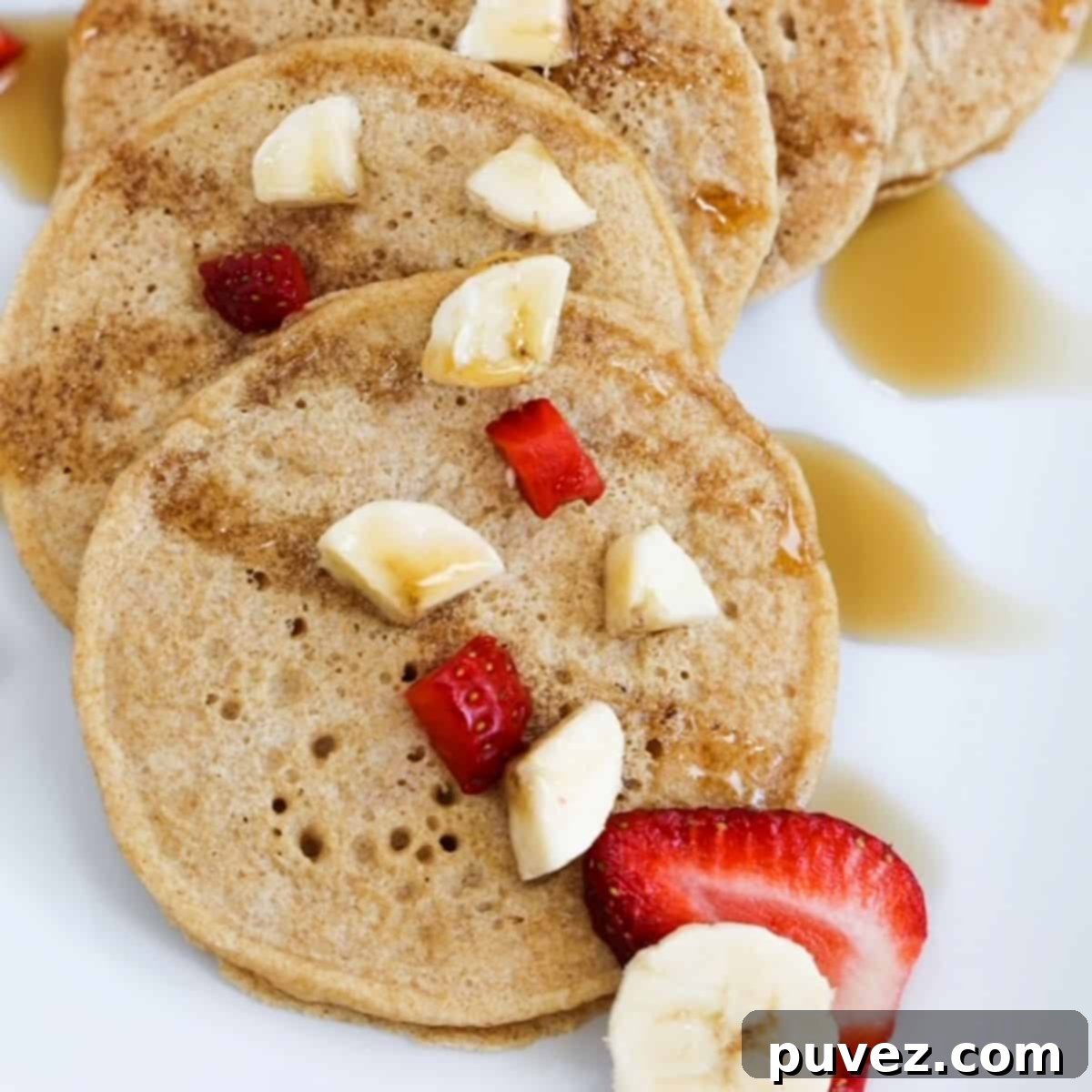Easy & Delicious Pancakes Without Milk or Butter: Your Ultimate Dairy-Free Recipe Guide
Imagine waking up craving warm, fluffy pancakes, only to realize you’re out of milk. Or perhaps you’re navigating dietary restrictions, needing a recipe free from dairy or butter. Don’t let these common hurdles stop you from enjoying a classic breakfast! This guide will show you how to whip up incredibly delicious homemade pancakes using just 4 basic pantry ingredients, completely without milk (of any kind) or butter. Not only is this recipe incredibly simple, but I’ll also share my secret trick to making pancakes in half the usual time, ensuring a quick and satisfying meal for any day of the week.
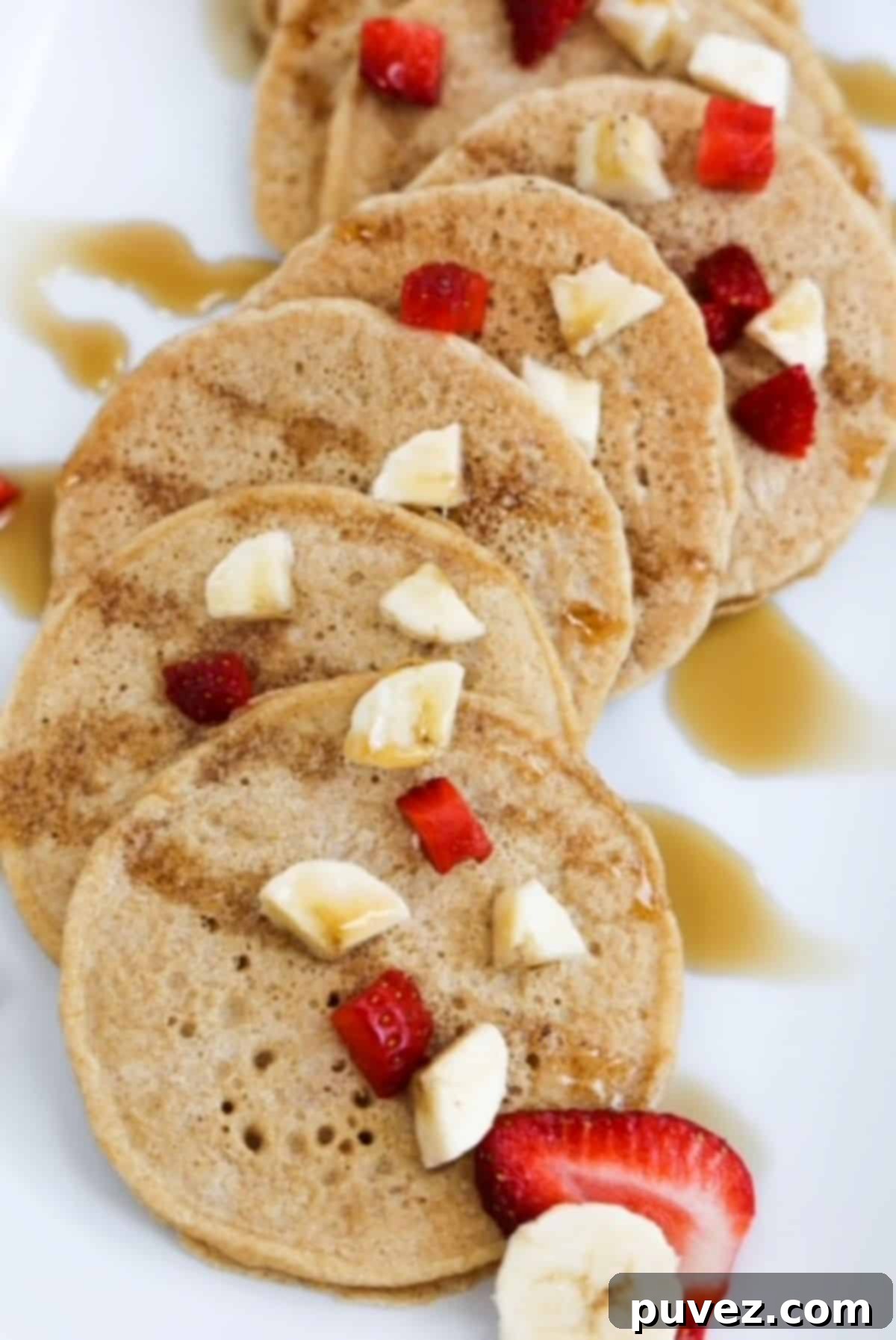
Have you ever found yourself searching for pancake mix on empty grocery store shelves? It’s a surprisingly common scenario, but it doesn’t have to be a problem. The truth is, making homemade pancakes from scratch is incredibly simple, relying on fundamental ingredients you likely already have in your pantry. This recipe is your go-to solution for those moments, offering a quick, convenient, and utterly delicious alternative to store-bought mixes.
I initially developed this recipe with standard ingredients, but after seeing the need for more versatile options, I decided to update it specifically for those who need to make pancakes without milk. Since milk contributes significantly to the substance and flavor of traditional pancakes, adapting the recipe required a bit of careful experimentation with the other components. The result is a uniquely light and satisfying pancake that you’ll adore, proving that dairy-free can still mean incredibly tasty!
These versatile pancakes are perfect for customizing. Top them with your family’s favorite fixings – think fresh berries, sliced bananas, a drizzle of maple syrup, or even a dollop of yogurt. You can also get creative with savory options! My son recently enjoyed his “taco-style,” folding them around scrambled eggs and cheese, while my daughter requested a pancake sandwich for her school lunch. Whether you prefer sweet or savory, this recipe provides a fantastic base for endless breakfast (or dinner!) possibilities. It’s a wonderful way to encourage kids to experiment with their food and make mealtime more exciting.
Why You’ll Love This Easy Dairy-Free Pancake Recipe
This recipe isn’t just about making pancakes; it’s about simplifying your life and expanding your meal options. Here are several reasons why these dairy-free pancakes will quickly become a household favorite:
- Effortlessly Easy Recipe: You truly only need one bowl to mix all your ingredients! This minimizes cleanup, making busy mornings (or evenings) much less stressful. The steps are straightforward, perfect for beginner cooks or for involving younger family members in the kitchen.
- Utilizes Simple Pantry Ingredients: Forget specialty store trips. This recipe relies on common staples like golden wheat flour, egg whites, olive oil, water, baking powder, salt, vanilla extract, and a touch of sugar. These are ingredients you probably already have on hand, making last-minute pancake cravings easy to satisfy.
- Delightfully Light and Airy Texture: While not the super-thick, “fluffy” pancakes you might get with buttermilk, these pancakes offer a wonderfully light and airy consistency. They are tender and melt-in-your-mouth, providing a refreshing alternative to heavier pancake varieties. This texture is achieved by carefully balancing the ingredients and incorporating egg whites.
- Completely Dairy-Free and Butter-Free: This is the ultimate pancake recipe when you’ve run out of milk, if you follow a vegan lifestyle (with an egg substitute), or if you have family members with dairy allergies or intolerances. It’s designed to deliver fantastic flavor and texture without any milk (cow’s milk, almond milk, oat milk, etc.) or butter, making it accessible to many.
- High in Fiber for Sustained Energy: By using whole grain flour (specifically white whole wheat flour), these pancakes provide a significant boost of dietary fiber. Serving whole grain pancakes for breakfast can help keep both you and your children feeling full and satisfied for longer, preventing those mid-morning energy crashes and promoting stable blood sugar levels.
- Ideal for Easy Meal Prep: Pancakes are incredibly versatile and excellent for meal prepping. They can be enjoyed fresh in the morning or saved for quick future meals. Make a larger batch on the weekend, and you’ll have breakfasts ready for days. One of my kids loves when I use smaller leftover pancakes to make a unique peanut butter and jelly “sandwich” for lunch, instead of bread. They’re also great for a “breakfast for dinner” night!
Key Ingredients for Perfect No-Milk Pancakes
Understanding each ingredient’s role is key to mastering these delicious dairy-free pancakes. Here’s a closer look at what you’ll need:
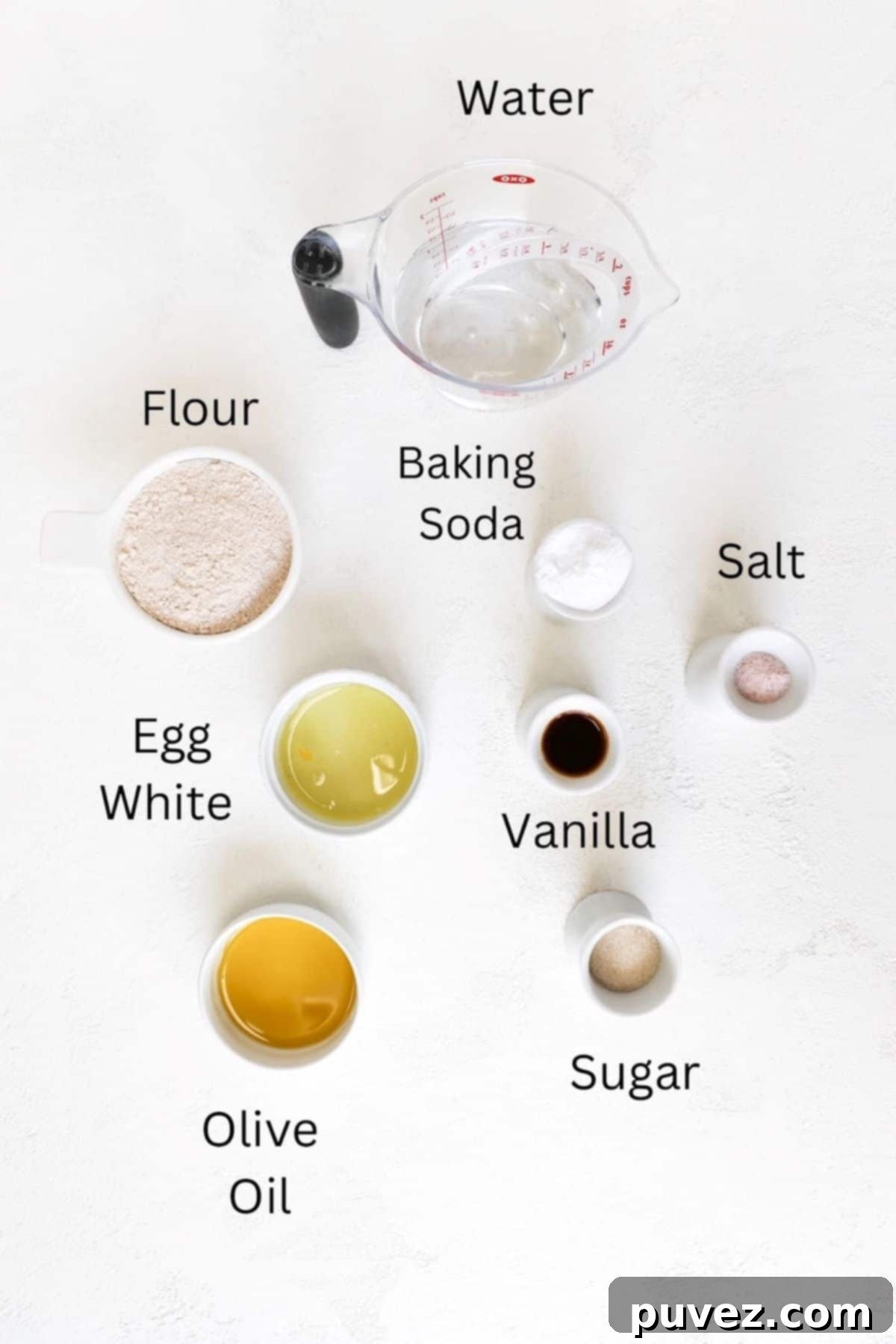
- White Whole Wheat Flour: This is a game-changer! Also increasingly known as Golden Wheat Flour, white whole wheat flour is unbleached and offers the same impressive nutritional value as traditional whole wheat flour. The key difference lies in the variety of wheat used, which results in a milder flavor, lighter color, and softer texture. This means you get all the health benefits of whole grains without the sometimes dense or nutty flavor associated with regular whole wheat flour, making these pancakes more appealing to everyone.
- Water: Yes, you read that correctly! This recipe cleverly uses plain water as the liquid base instead of any kind of milk. When combined with the other ingredients, particularly the egg whites and olive oil, the water helps create a light batter that cooks up beautifully. It’s the simplest and most accessible way to ensure your pancakes are completely dairy-free.
- Egg Whites: This recipe specifically calls for the egg whites from two large eggs. Using only the whites contributes to a lighter, airier pancake texture, preventing them from becoming too dense. The protein in the egg whites also provides structure and helps create those desirable small bubbles when cooking. If you only have whole eggs, you can substitute one whole egg for two egg whites, but be aware that your pancakes may turn out slightly denser.
- Olive Oil: Instead of butter, which would introduce dairy, this recipe uses olive oil. Olive oil adds moisture and richness, contributing to a tender crumb without imparting a strong flavor. While extra virgin olive oil works perfectly, a lighter olive oil or even another neutral-flavored oil like canola or vegetable oil can be used. If you don’t need a dairy-free pancake recipe and prefer the flavor of butter, you can easily substitute two tablespoons of melted butter for the olive oil.
- Baking Powder & Salt: These are essential leavening agents that work together to create the lift and texture in the pancakes. The baking powder reacts with the liquid to produce carbon dioxide bubbles, making the pancakes light and airy. Salt balances the sweetness and enhances all the flavors.
- Sugar & Vanilla Extract: A small amount of sugar adds just the right touch of sweetness to these pancakes, making them palatable even without the natural sugars found in milk. Pure vanilla extract is crucial for adding depth of flavor and a warm, comforting aroma, helping to compensate for the flavor profile that milk would typically provide.
Dietitian Tip: Engaging Kids in Breakfast Choices
As a dietitian, I often observe that mealtimes with children can be a struggle, especially on busy mornings. A fantastic strategy to lessen this battle and give your kids a sense of autonomy is to involve them in the decision-making process for breakfast. Instead of simply presenting a plate, ask them how they would like their breakfast served. This small act of choice can make a huge difference in their willingness to eat.
For instance, a child who typically refuses eggs might surprise you by happily eating them if they’re wrapped inside a warm pancake, creating a mini breakfast burrito. Similarly, a child who isn’t fond of plain pancakes might be delighted by the idea of topping them with creamy vanilla yogurt and fresh strawberries, transforming them into a fun “breakfast taco.” Sometimes, the reluctance isn’t about the food itself, but rather about the presentation or the lack of control they feel.
Whether I’m serving these homemade pancakes or wholesome pumpkin waffles, I always offer my kids options for toppings. I present choices like slices of fresh fruit (bananas, berries, apples), a variety of nut butters (peanut butter, almond butter), and of course, a classic drizzle of maple syrup. This not only encourages them to eat but also helps them explore different flavors and textures, fostering a healthier relationship with food.
How to Make Easy Dairy-Free Pancakes: Step-by-Step
Making these wholesome pancakes without milk is a straightforward process that comes together quickly. Here’s a detailed overview of the steps. For the precise measurements and full ingredient list, please scroll down to the complete recipe card.
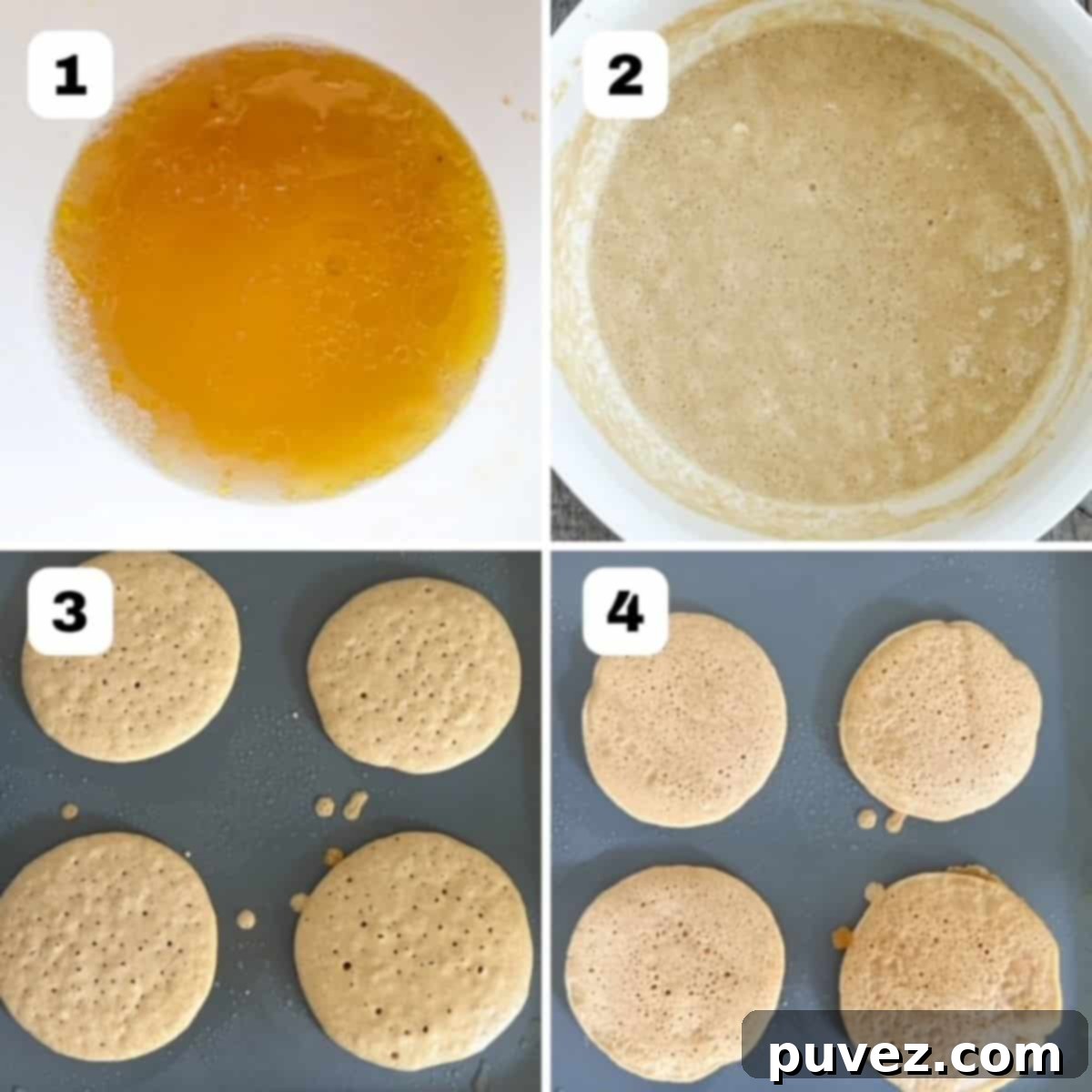
- Whisk Egg Whites: Begin by adding the egg whites to a medium or large mixing bowl. Whisk them vigorously for about 30 seconds until small bubbles start to form. This light whisking incorporates air, contributing to the airy texture of the finished pancakes.
- Add Water and Whisk Again: Pour the water into the egg whites and continue to whisk for another 30 seconds. The liquid mixture will develop a foamy layer on top, indicating it’s well combined and aerated.
- Incorporate Flavor and Fat: Gently whisk in the vanilla extract and olive oil. The mixture will maintain its slightly foamy appearance. These ingredients are crucial for both flavor and moistness.
- Mix in Dry Leavening and Sweetener: Add the sugar, baking powder, and salt to the wet ingredients. Stir these in briefly to combine.
- Introduce Flour: Gradually add the white whole wheat flour to the bowl. Stir just until all of the flour is moistened and combined. It’s perfectly normal, and even desirable, for the batter to have a few small lumps. Overmixing can develop the gluten in the flour too much, leading to tough pancakes.
- Rest the Batter: Let the pancake batter sit undisturbed for approximately 3 to 5 minutes. This crucial resting period allows the flour to fully hydrate and the baking powder to begin its work, resulting in lighter, more evenly cooked pancakes. Do not skip this step!
- Preheat Griddle: While the batter is resting, place your griddle pan on medium heat and allow it to heat up fully. Ensure it is adequately greased. A well-heated pan is essential for perfectly browned pancakes.
- Cook Pancakes: Once the griddle is hot, pour about 2 tablespoons of batter per pancake onto the pan, leaving enough space between them for easy flipping. For uniform pancakes, a small ladle or ice cream scoop works wonders.
- Flip and Finish: Cook the pancakes for about two minutes per side. You’ll know they’re ready to flip when the edges look lightly golden brown and the surface of the pancake is covered with small, diminishing bubbles. Carefully use a small spatula to flip them over and cook for an additional two minutes, or until both sides are golden brown and the pancakes are fully cooked through.
- Serve Warm: Serve your fresh, dairy-free pancakes immediately with your favorite toppings!
My Top Trick for Making Pancakes in Half the Time!
This might seem like common sense to some, but it genuinely took me years of pancake-making to realize this simple, yet revolutionary, efficiency hack: use two stovetop griddle pans simultaneously! This strategy effectively doubles your cooking surface and allows you to cook a significantly larger batch in the same amount of time. Instead of waiting for one batch to finish before starting the next, you can have up to 8 four-inch pancakes cooking at once. Genius, right? This dramatically reduces the overall cooking time, ensuring everyone can enjoy warm pancakes together.
If you don’t own two dedicated griddle pans, don’t worry! Large, flat skillets work just as well. Most standard large skillets can comfortably fit 3 pancakes, meaning you can still cook 6 pancakes at a time with two skillets. Give it a try next time you make pancakes and let me know how much time it saves you!
Helpful Tips for Perfect Dairy-Free Pancakes
Achieving consistently perfect pancakes involves a few simple tricks. Keep these helpful tips in mind for the best results:
- Batter Consistency: This recipe yields a relatively thin batter, which contributes to its light and airy texture. If you prefer a slightly thicker pancake, you can carefully stir in an extra tablespoon or two of flour. However, be mindful that because this recipe uses whole grain flour, adding too much extra flour can make the pancakes heavier and denser.
- Proper Pan Preparation: Always ensure your cooking pans are hot and adequately greased before you pour any batter. A properly heated and greased surface prevents sticking and promotes even browning, creating that desirable golden crust.
- Greasing Recommendation: I highly recommend using avocado oil spray to grease your pans. Avocado oil has a high smoke point, meaning it can withstand high heat without breaking down or smoking, making it ideal for griddle cooking.
- Medium Heat is Key: Cook your pancakes on medium heat. It’s tempting to crank up the heat to speed things up, but doing so can lead to burnt exteriors and raw interiors. Medium heat allows the pancakes to cook evenly through, ensuring a beautiful golden brown on both sides. Patience is rewarded here!
- The Importance of Batter Rest Time: Do not skip the 3-5 minute resting period for the batter. This step is critical! It allows the flour to absorb the liquids fully and the baking powder to activate properly. Skipping this can result in very flat, dense pancakes that lack the desired lift and texture.
- Flour Substitution: While this recipe is optimized for white whole wheat flour for its nutritional benefits and mild flavor, I have no doubt that you could successfully substitute all-purpose flour if that’s what you have on hand. The texture might be slightly different, but the pancakes will still be delicious.
- Storage for Leftovers: Always allow pancakes to cool completely before storing them. This prevents condensation from forming and making them soggy. Once cooled, stack them in an airtight container or a freezer-safe resealable bag for storage in the refrigerator (for up to 3 days) or freezer (for up to 3 months).
- Reheating Frozen Pancakes: To reheat frozen pancakes, you can either let them thaw in the refrigerator overnight or separate them while still frozen and warm them in a toaster, microwave, or air fryer until heated through.
Frequently Asked Questions About Milk-Free Pancakes
Absolutely, yes! This recipe is living proof that you can make incredibly satisfying pancakes without any type of milk, dairy or otherwise. When substituting water for milk in a pancake recipe, it’s beneficial to make a few adjustments to ensure a good flavor and texture. Milk provides both substance and a certain richness. Therefore, I recommend incorporating vanilla extract for a deeper flavor profile and potentially adjusting the flour slightly to achieve the right consistency. My recipe is specifically balanced to achieve this, delivering a light and flavorful pancake despite the absence of milk.
Generally, the fluffiest pancakes are achieved through ingredients like buttermilk (which reacts strongly with baking soda) or by using a generous amount of baking powder. While this specific recipe for milk-free pancakes aims for a light and airy texture rather than extreme fluffiness (due to the absence of milk and the use of whole grain flour which can be heavier), I have increased the baking powder slightly to give them a good lift. I was careful not to add too much, as an excess can sometimes leave a metallic aftertaste. Additionally, using egg whites instead of whole eggs helps prevent the pancakes from becoming too dense, contributing to their overall lightness. For ultra-fluffy pancakes, you would typically need a different type of flour and a specific leavening agent balance, often including an acidic component like buttermilk.
Yes, absolutely! Freezing pancakes is a fantastic meal prep strategy that I use all the time. To ensure the best quality and prevent them from sticking together, you can freeze them individually on a baking sheet for a few hours until solid, then transfer them to a freezer-safe resealable bag. This method keeps them from clumping. However, if you’re like me and often short on time, you can simply let the pancakes cool completely before stacking them directly into a freezer-safe bag. I press out as much air as possible before sealing the bag and then freeze them for up to 3 months. To defrost, you have a few options: you can transfer a bag from the freezer to the refrigerator overnight, or, if you need them quickly, pull the pancakes apart while still frozen and reheat them individually in a toaster, microwave, or air fryer until warm throughout. They’ll taste almost as good as fresh!
More Delicious Breakfast Ideas
- Whole Wheat Blueberry Pancakes
- Protein Pancakes
- Whole Wheat Pumpkin Waffles
- Mini Banana Pancakes
Explore More Breakfast Recipes
- Best Gingerbread Muffins Recipe
- Mini Banana Pancakes
- How to Make Steamed Hard-Boiled Eggs
- 16 Ways to Increase Protein in Smoothies without Protein Powder
Now that you know how incredibly easy and delightful these pancakes without milk are, why not give them a try? We’d love to hear your thoughts! Please leave a 5-star review or comment below to share your experience. Your feedback helps other home cooks discover this fantastic recipe!
Don’t forget to follow me on Instagram for daily meal inspiration, quick cooking tips, and valuable nutrition advice!
📖 Recipe
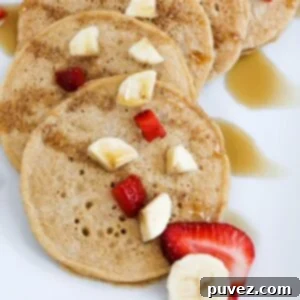
Homemade Dairy-Free Pancakes Without Milk
KristiEquipment
-
1 Mixing bowl
-
1 Whisk
-
1 Stovetop Griddle Pan Can use two to cut the time in half.
-
1 measuring cups and spoons
-
1 small spatula
Ingredients
- 2 egg whites
- 1⅓ cup water
- 2 tablespoon olive oil extra virgin
- 1 teaspoon vanilla pure vanilla extract
- 2 tablespoon sugar
- 1 tablespoon baking powder aluminum-free
- ½ teaspoon salt
- 1¼ cup white whole wheat flour
Instructions
-
Add egg whites to a mixing bowl and whisk for about 30 seconds until slightly foamy.
-
Add water to the egg whites. Whisk for another 30 seconds until the liquid mixture has a foamy top.
-
Whisk in the vanilla extract and olive oil until well combined.
-
Stir in the sugar, baking powder, and salt. Then, gently fold in the white whole wheat flour just until all the flour is mixed in. Be careful not to overmix; some small lumps are perfectly fine and even preferred for tender pancakes.
-
Let the pancake batter rest for 3-5 minutes. This allows the flour to fully hydrate and the leavening agents to activate, resulting in lighter pancakes.
-
While the batter rests, heat a greased square griddle pan (or two for speed!) on medium heat. Ensure the pan is hot before adding batter.
-
When the pan is hot, add about two tablespoons of batter per pancake, ensuring they are spaced out on the pan. Approximately 4 small pancakes should fit comfortably on one standard square griddle pan.
-
Cook for about 2 minutes. You’ll know they’re ready to flip when the edges appear cooked and lightly golden brown, and the entire surface is covered with small bubbles. Use a small spatula to carefully flip the pancakes over. Cook for an additional 2 minutes, or until the pancakes are golden on both sides and cooked through.
-
Serve warm with your favorite toppings and enjoy your delicious dairy-free pancakes!
Notes
-
- Batter Consistency: This batter is intentionally thin for a lighter pancake. If you prefer a thicker pancake, you can gradually stir in a few extra tablespoons of flour. However, be aware that adding too much whole grain flour can result in a heavier, denser pancake.
- Cooking Heat: Always cook your pancakes on medium heat. Resist the urge to increase the heat beyond medium, as this can lead to uneven cooking, with burnt outsides and undercooked centers. Consistent medium heat ensures a perfectly cooked pancake every time.
- Pan Preparation: Ensure your pans are properly heated and thoroughly greased before you add the batter. This is essential to prevent sticking and achieve a beautiful golden crust.
- Greasing Tip: For best results, I recommend using avocado oil spray to grease your pans. Avocado oil has a high smoke point, making it excellent for high-heat cooking without burning.
- Resting the Batter: Do not skip the 3-5 minute resting period for the batter. This crucial step allows the flour to fully absorb moisture and the leavening agents to activate, contributing significantly to the pancakes’ light and airy texture. Without it, your pancakes may be flat and dense.
- Sugar Adjustment: The amount of sugar in this recipe is balanced to provide good flavor without milk. I tested reducing the sugar, but the pancakes lacked taste. If you were to use milk instead of water (though this recipe is dairy-free), you might be able to halve the sugar, as milk contains natural sugars.
- Flour Alternatives: While white whole wheat flour is recommended for its unique properties, if you only have all-purpose flour available, it can be substituted. The texture might differ slightly, but the pancakes will still be delicious.
- Storing Leftovers: Allow pancakes to cool completely before storing them in the refrigerator or freezer. This prevents them from becoming soggy due to condensation.
- Freezing Instructions: To freeze pancakes, place the completely cooled pancakes in a freezer-safe resealable bag. They can be stored in the freezer for up to three months. To prevent them from sticking together, you can initially freeze them in a single layer on a baking sheet for an hour or two before transferring them to the bag. If you don’t have time for this step, you might need to gently pull them apart when ready to reheat.
